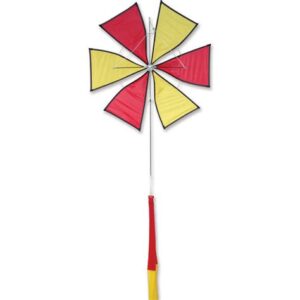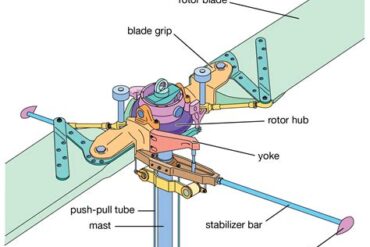Understanding the Mechanics of Rotor Kites
1. The Science Behind Rotor Kites
Rotor kites operate based on principles of aerodynamics and kinematics. By incorporating rotating blades, similar to those found on helicopters, rotor kites can harness the wind in a way that allows them to ascend and maneuver more effectively than their traditional counterparts. When the blades rotate, they create a low-pressure area above the wings, generating lift through the differences in air pressure.
2. Components of a Rotor Kite
A typical rotor kite consists of several key components:
-
Frame: The structural skeleton that provides shape and support.
-
Rotors: The rotating blades that catch the wind and generate lift.
-
Sails: The fabric that forms the body of the kite, providing aerodynamic surfaces.
-
Control Lines: The lines that allow the operator to control the kite’s movements.
-
Bridle System: A network of lines that help in balancing and stabilizing the kite.
These components work together to create a cohesive and efficient flying system. The materials used in constructing rotor kites are often lightweight yet durable, ensuring optimal performance under various weather conditions.
Advantages of Rotor Kites Over Traditional Kites
1. Enhanced Lift and Thrust
One of the most significant benefits of rotor kites is their ability to generate greater lift and thrust compared to traditional kites. The rotating blades allow rotor kites to take advantage of vertical wind currents, which can lead to increased altitude and more extended flight durations. This advantage makes rotor kites particularly appealing for aerial applications such as photography, surveying, and scientific research.
2. Superior Maneuverability
Rotor kites offer unparalleled maneuverability, allowing operators to execute complex aerial maneuvers with ease. The ability to control the angle of the rotors enables pilots to change direction quickly, making rotor kites an excellent choice for aerial sports and competitive flying. Whether performing tricks or navigating through obstacles, rotor kites can adapt to various flight conditions, providing a thrilling experience for enthusiasts.
3. Stability in Turbulent Conditions
Rotor kites are designed to maintain stability even in challenging wind conditions. The dynamic nature of the rotating blades helps stabilize the kite, reducing the risk of erratic movements or crashes. This stability makes rotor kites a suitable option for beginners and experienced flyers, as they can handle turbulent weather without compromising performance.
Types of Rotor Kites
1. Single-Rotor Kites
Single-rotor kites feature a single set of rotating blades, making them lightweight and easy to handle. These kites are often used for recreational flying and are ideal for beginners. Their straightforward design allows users to learn the fundamentals of kite flying before progressing to more advanced models.
2. Multi-Rotor Kites
Multi-rotor kites incorporate multiple sets of rotating blades, resulting in increased lift and stability. These kites are often utilized in professional applications, such as aerial photography and surveying. The added complexity of multi-rotor designs allows for more control and precision during flight, making them favored among experienced pilots.
3. Hybrid Rotor Kites
Hybrid rotor kites combine elements of traditional kites and rotor kites, offering a unique flying experience. These kites may feature fixed wings alongside rotating blades, providing the benefits of both designs. Hybrid rotor kites are versatile and can be adapted for various purposes, from recreational flying to competitive events.
Applications of Rotor Kites
1. Aerial Photography and Videography
Rotor kites have gained popularity in the fields of photography and videography due to their ability to reach impressive altitudes while maintaining stability. Photographers can capture stunning aerial shots from unique perspectives, allowing for creative storytelling and dynamic imagery. The smooth flight patterns of rotor kites enable consistent footage, making them invaluable tools for professionals in the industry.
2. Environmental Monitoring and Research
Researchers utilize rotor kites for environmental monitoring and data collection. The ability to fly at various altitudes makes these kites suitable for studying atmospheric conditions, wildlife behavior, and other ecological phenomena. By deploying sensors and cameras from rotor kites, scientists can gather crucial data without disturbing the natural environment.
3. Search and Rescue Operations
Rotor kites can play a critical role in search and rescue missions. Their ability to fly at low altitudes while covering vast areas makes them effective for locating missing persons or assessing disaster-stricken regions. By equipping rotor kites with thermal imaging cameras and communication devices, rescue teams can enhance their operational efficiency and improve response times.
Choosing the Right Rotor Kite
1. Skill Level
When selecting a rotor kite, it is essential to consider the user’s skill level. Beginners may opt for single-rotor kites, which are more forgiving and easier to control. In contrast, experienced pilots may prefer multi-rotor kites for their advanced features and capabilities.
2. Intended Use
The purpose of the kite will also influence the choice. For aerial photography, a multi-rotor kite with a stable platform is ideal, while recreational flyers may enjoy the simplicity of single-rotor designs. Understanding the intended application will help narrow down the options.
3. Budget
Rotor kites are available in a range of price points. It is crucial to establish a budget before shopping, as this will help filter out options that may not be feasible. Investing in a quality kite can lead to better performance and longer-lasting enjoyment.
Maintenance and Care for Rotor Kites
1. Regular Inspections
To ensure optimal performance and safety, regular inspections of rotor kites are essential. Check the frame for any signs of wear and tear, and examine the rotors for damage. Ensuring that all components are in good condition will help prevent accidents during flight.
2. Cleaning and Storage
Keeping the kite clean is vital for its longevity. After each flight, remove dirt and debris from the frame and sails. Store the kite in a cool, dry place, preferably in a protective bag, to shield it from harsh environmental conditions.
3. Replacement Parts
Be prepared to replace worn-out components as needed. Having spare parts on hand, such as rotors and control lines, can help maintain the kite’s performance and minimize downtime.
Conclusion: The Future of Rotor Kites
Rotor kites represent a significant advancement in kite technology, offering numerous benefits over traditional designs. Their unique mechanics, enhanced maneuverability, and diverse applications make them an attractive option for both recreational and professional users. As technology continues to evolve, we can expect to see even more innovative designs and applications for rotor kites in the future. Whether used for leisure, research, or aerial photography, rotor kites will undoubtedly remain a fascinating subject in the world of aviation and outdoor activities.

